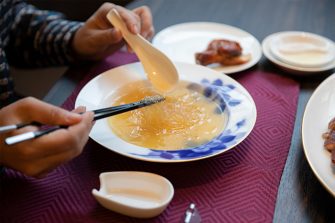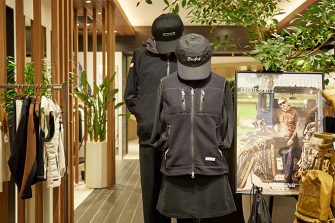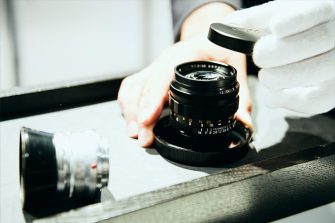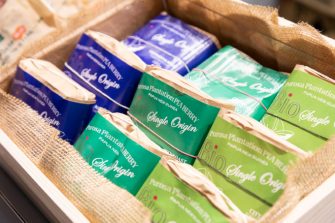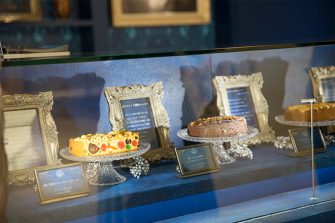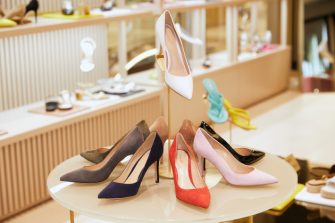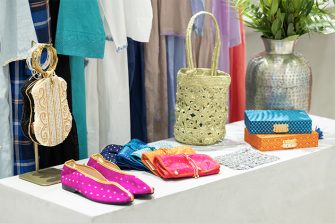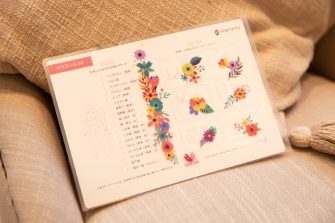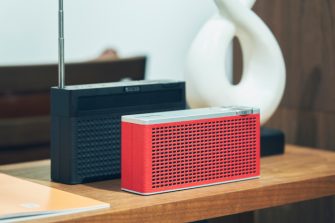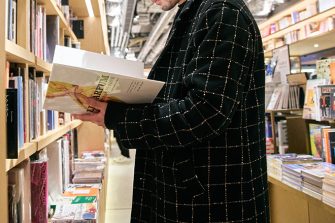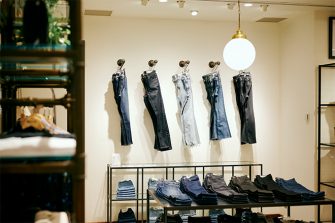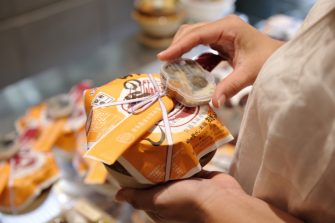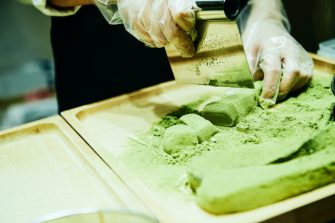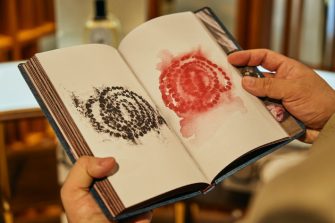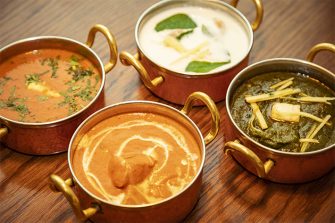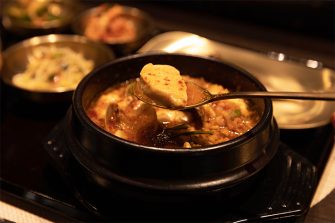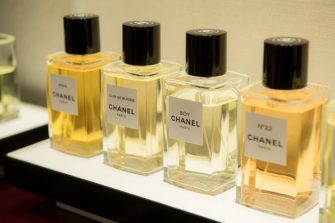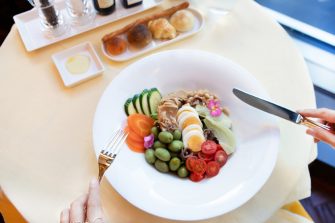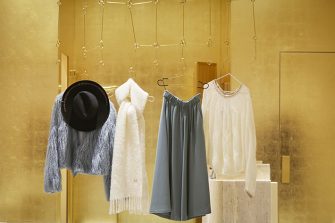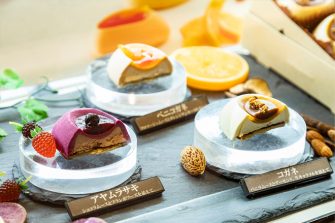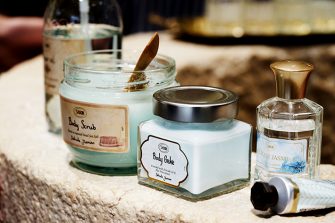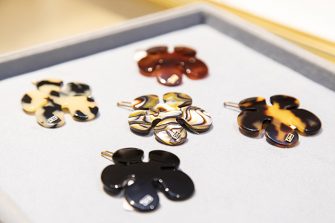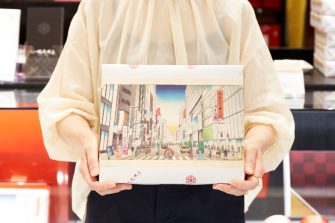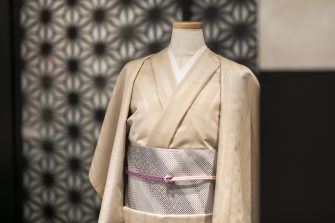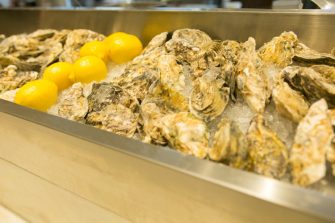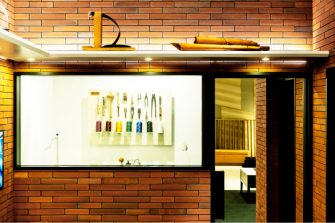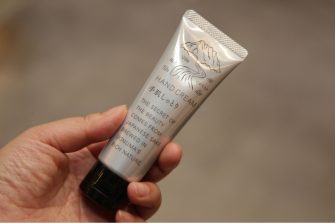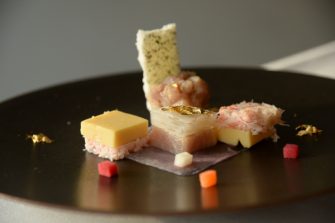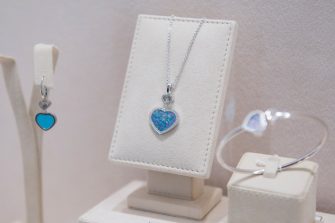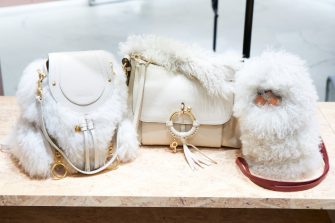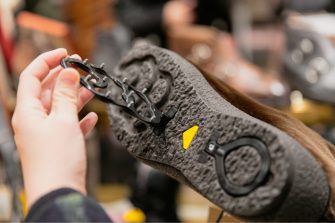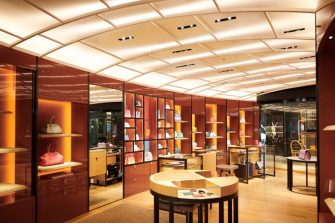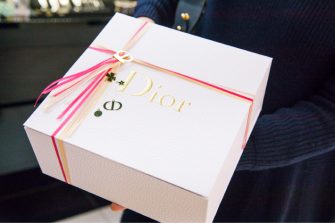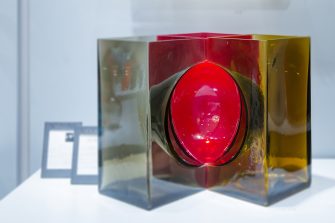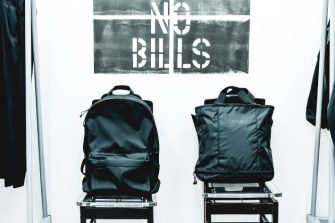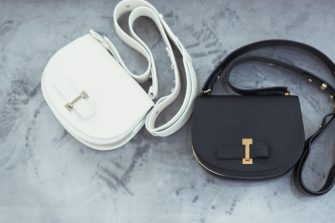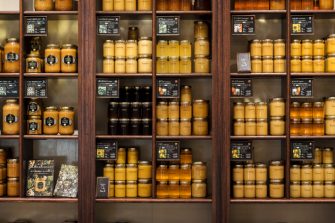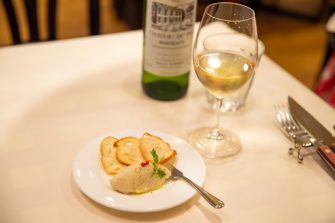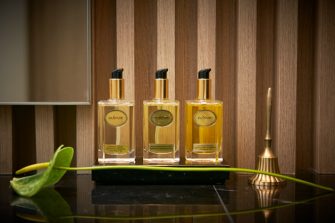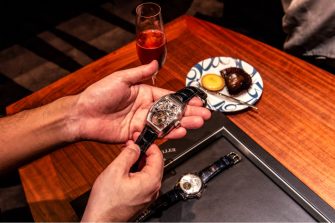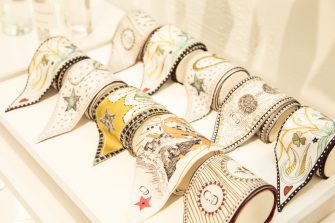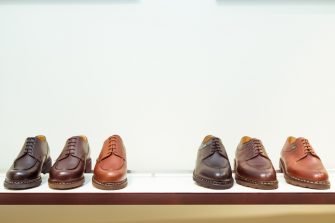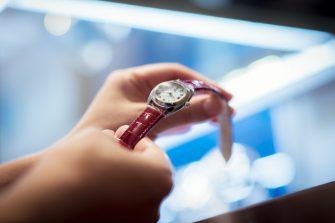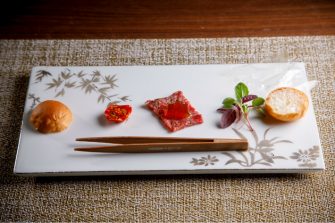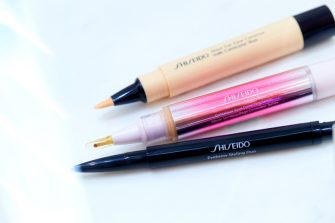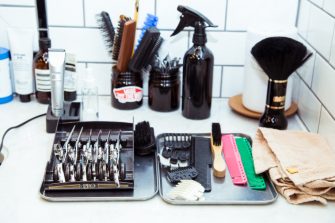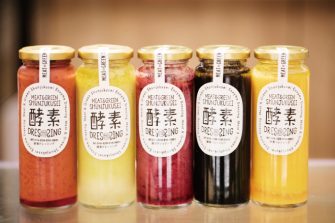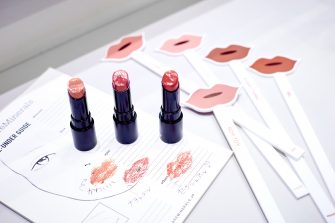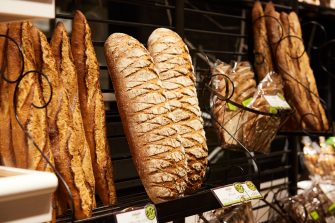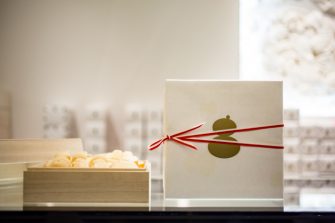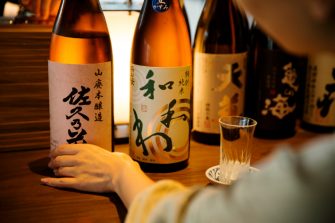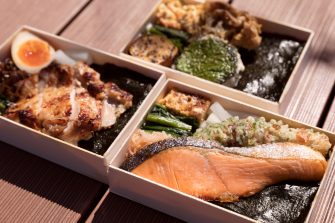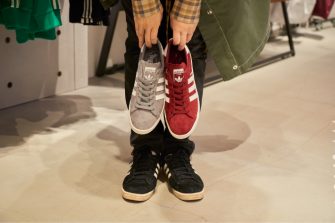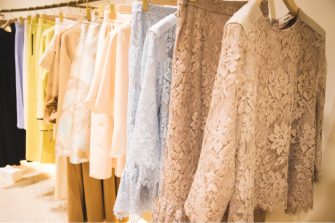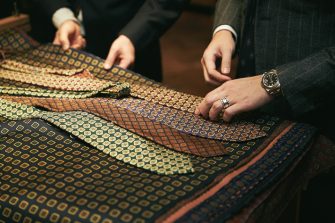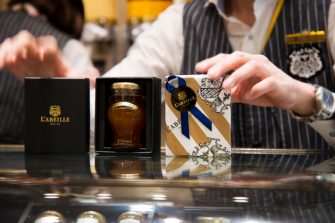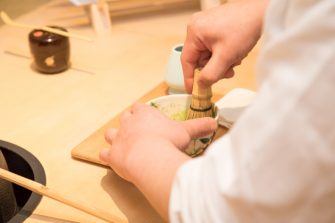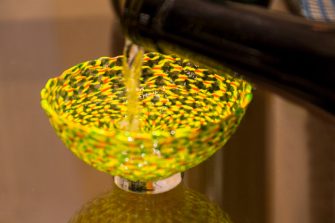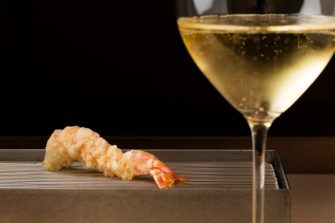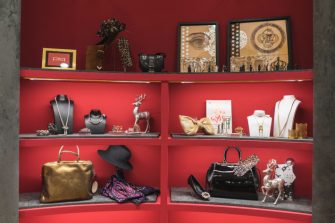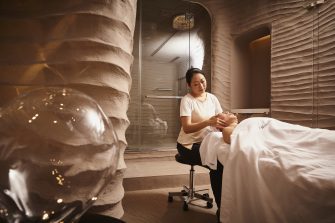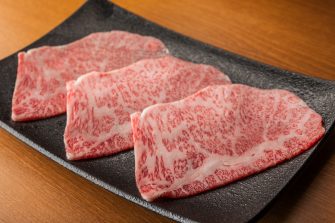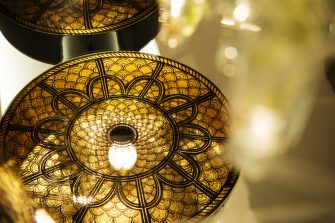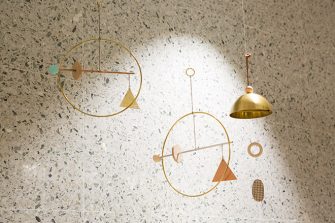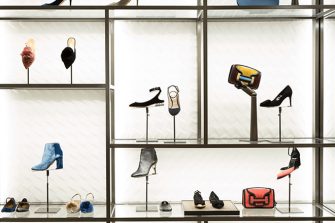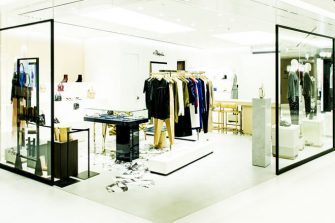

GINZA SIX EDITORS
ファッション、ジュエリー&ウォッチ、ライフスタイル、ビューティ、フード…
各ジャンルに精通する個性豊かなエディターたちが、GINZA SIXをぶらぶらと
歩いて見つけた楽しみ方を綴ります。
僕のリアルないつものGINZA SIX「気絶散歩コース」 My Regular Real GINZA SIX Walking Course (Eliciting Swoons)
干場 義雅
GINZA SIX EDITORS Vol.93
たまたまなんですが、東京で三代続くテーラーの家系に生まれたこともありまして…、何かと銀座界隈には子供の頃から父に連れて来てもらう機会が多かったんです。生地屋さん、付属のボタン屋さんのある問屋街を車で回った後、最後に洋服屋さんがあった銀座に寄る。それが、父のいつもの仕事のコースでした。
僕が20歳になる頃には、「成人になるんだから一着は良いスーツを持っていた方がいい!」と言ってネイビーのスーツを仕立ててくれました。「大人になるんだから、こういう場所も知っておくべきだ!」と言って、そのスーツを着て銀座の高級クラブに連れて行ってもらったんです。バブル後ということもあったと思うんですが、普段、見たこともないような、美しく化粧をした良い香りのする女性ばかりで……。「いいなぁ〜綺麗なオネエさんって」って思った記憶があります(笑)。
銀座の街が身近に感じられるようになったのは、26歳の頃。編集者になって出版社を点々とした後、しばらくして、人気雑誌『LEON』の編集部員になった頃です。銀座一丁目、京橋あたりに編集部があり、その頃毎日のように通っていたので、かなり銀座に詳しくなっていました。
そんな僕にとって、いろいろな思い出がある銀座の中でも、好きな場所がGINZA SIX。理由は好きなお店が揃っているからです。ということで、いつも僕が行っている気絶散歩コースをチラッとご紹介します。
まずは、入り口を入って3Fの「DSQUARED2(ディースクエアード)」へ。そこから左斜め向かいの「Neil Barrett(ニール バレット)」を見に行き、エスカレーターで5Fに上り「Gente di Mare(ジェンテ ディ マーレ)」へ。さらに6Fの「銀座大食堂」でご飯を食べてからの「銀座 蔦屋書店」へ。
どこも僕のスタイル=“干場型”を作るために欠かせないブランドであり大好きな店です。
ということで、この日も最初に繰り出したのは、ミラノコレクションに参加しているキャッチーなアイテムが多い「ディースクエアード」。
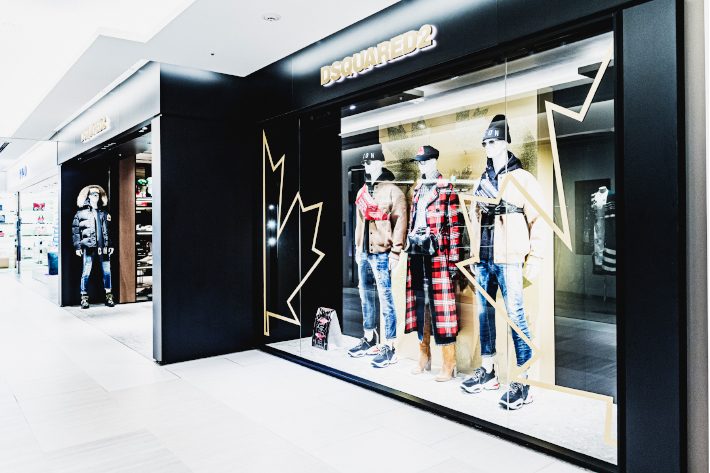
なかでも僕のお気に入りはデニム。
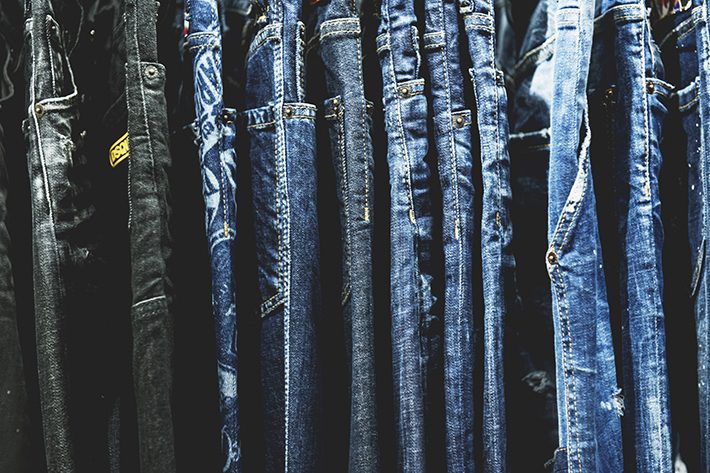
「TIDY BIKER(タイディバイカー)」というタイプで、股上が深く、太腿から裾にかけてテーパードしているシルエットのもので、腰履きを前提に考えられたモデルです。ディースクエアードは腰履きであえて足を短く見せて、あわよくば腹斜筋をアピれてしまう胴長バランスをいち早く確立した最初のブランドなんですよね。この日も早速、2019年秋冬モデルのタイディバイカー(60,000円 ※以下全て税抜価格)を試着しました。
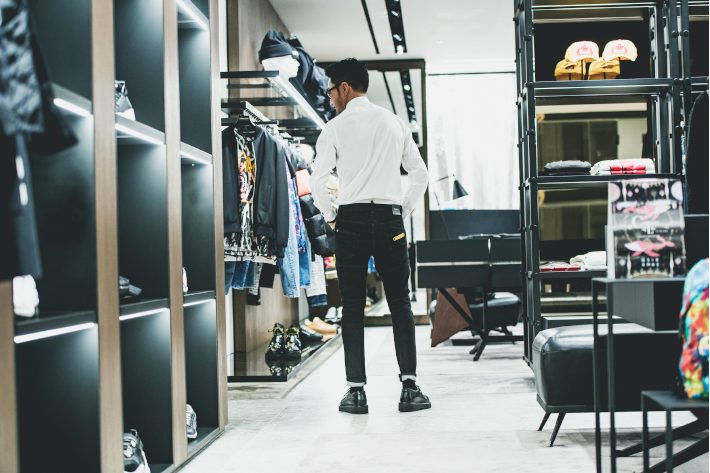
僕の場合、できるだけ無駄を省き、色や柄は使わず、風景に馴染み、装う人の魅力が最大限引き出されるスタイルを理想としているので、40本近く持っているデニムも黒が大半。最近はもう一本ブラックデニムを新調したいと思っていたこともあって、今回もすっかり買い物モードになっちゃいました。

ディースクエアードのデニムはジッパーの横にあるこんなタグの位置もセクシーポイント(笑)。僕は現在46歳。23歳の頃から通っているので、もう23年間もミラノコレクションを見ているんですが…。ディースクエアードのショーに出てくる水着を着たメンズモデルたちは、ほとんどと言っていいほど、みんな筋肉がバッキバキに割れているんです。これが、めちゃくちゃカッコイイ。セクシーで、ヘルシーなんです。
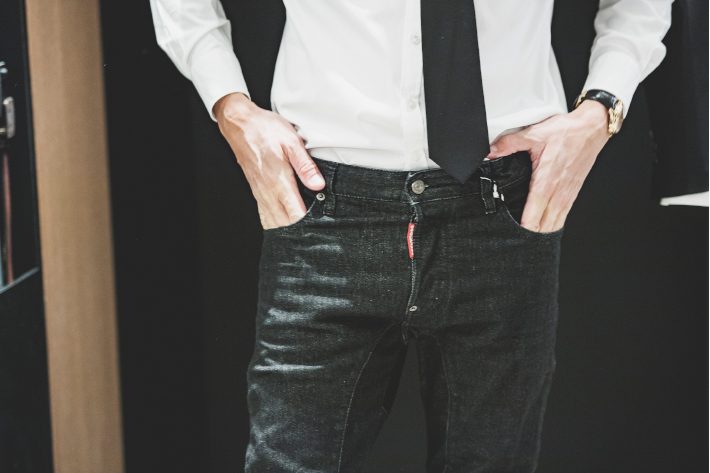
ちなみにミラノのディースクエアードの本社には会員制ジムとスパが併設されていて、最上階には「Ceresio 7(チェレジオセッテ)」という、ブルガリホテルにいたシェフであるエリオ・シローニが腕をふるう僕も大好きなイタリアンレストランがあります。プールもあるので、夏の時期にはミラノのお洒落な業界人たちのたまり場になっています。空間デザインはディースクエアードのデザイナーである双子のディーンとダンが手がけていて、彼らのコレクションでもあるバスキアやジャン・コクトーの絵も必見です。「美味しいものを食べて、鍛えて、ファッションを楽しもう」というブランドの姿勢を体現している場所なので、機会があったら、皆さんもぜひ行ってみてくださいね。
ディースクエアードは、デニムはもちろんですがスーツもおすすめ。ストレッチが効いていて、肩のラインとかがすごくきれいなんです。この日試着したのは1つボタンのジャケットがタイトなスーツのセットアップ(158,000円)。
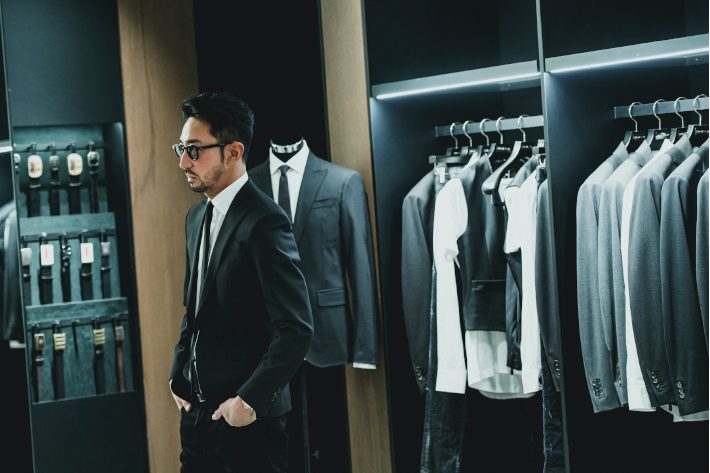
短い丈のジャケットを着てピッティにやってくる日本人の真似をして生み出されたことから、このスーツには「TOKYO」という名前が付いていて、他にもディースクエアードのスーツには世界の都市の名前が冠されています。
「上半身はきっちり見せておいて、下半身は腰履きでルーズ」というのが、ディースクエアードの流儀なのです。ということで次は「ニール バレット」のお店へ。
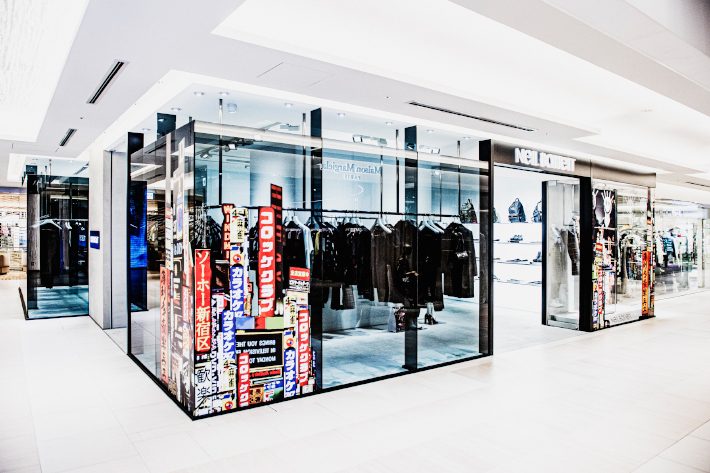
このブランドで僕が強くおすすめしたいのは、究極のトラベルスーツ! 上下別々で買うことができるセットアップなんですが、テクノストレッチという素材がシワになりづらいし、伸縮性があるから着ていてラクだし、生地もしっかりしていて復元力も高いから、クリースは綺麗に入るし、膝も抜けにくい。
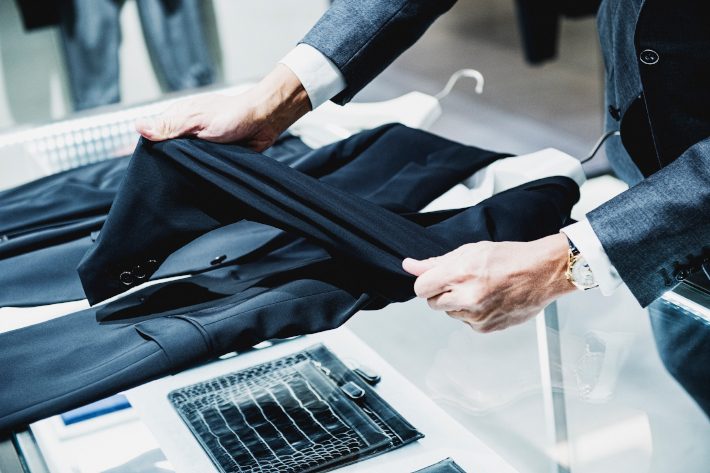
デザイナーのニール・バレットはかつてプラダウォモのディレクターだった頃からスーツ作りには定評がありました。ニール バレットとして自身のブランドを立ち上げた後も、僕が思い描くこんなモダンなスーツ(ジャケット139,000円・パンツ65,000円)をデザインしてくれて、もはや手放せません。このセットアップだけで、色違いで7着ぐらい愛用しています。
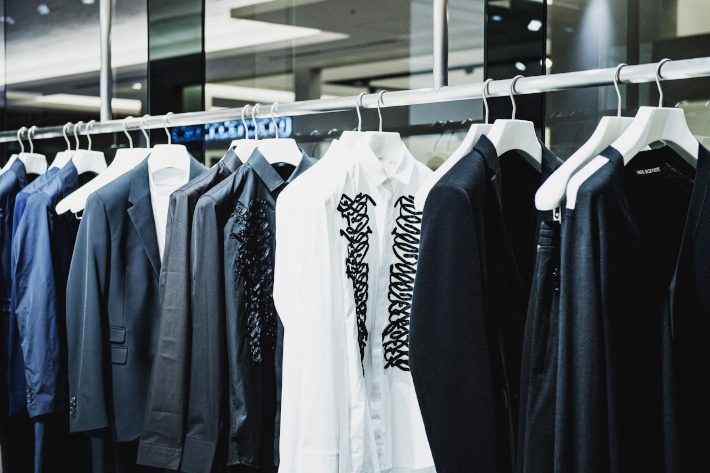
ちなみについ最近はこのスエットパンツ(76,000円)を購入。年間でトータル2ヵ月くらいは海外出張に出る僕にとっては、復元力が高くて膝が抜けにくいスエットパンツは、機内用にとても重宝するのです。
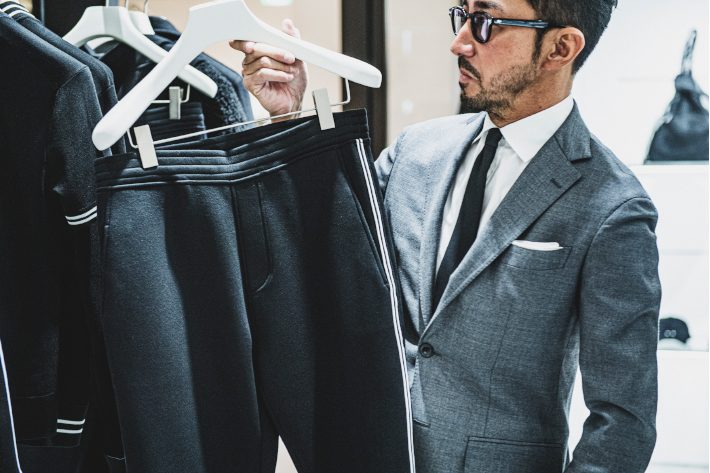
続いては「ジェンテ ディ マーレ」へ。イタリアの海辺にある洋服屋さんをテーマにしたセレクトショップですが、ヨーロッパのブランドだけで固めている店は他にほとんど皆無なのと、いつ来ても男が好きなものや知らないものに出合えるので、とても好きなお店です。
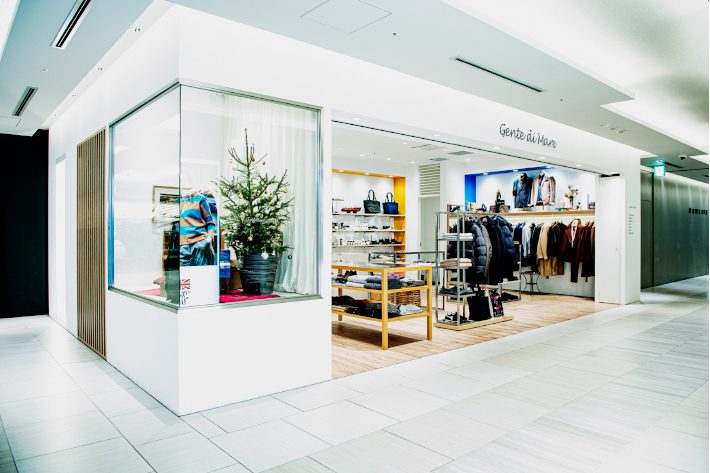
例えばイタリアのプーリア州で2010年に誕生したアウターブランド「HEVO(イーヴォ)」のネイビーのコート(79,000円)。ここ数年、コートの趣がぐっと変わったと思うんですが、ビッグシルエットや丸みを帯びたAライン、ラグランスリーブのドロップショルダーといった女性のトレンドがメンズにも波及してきていて、その先駆けとなったのがこのブランドなんです。

主に上質なウールを使っていて、ウエスト部分にベルトが付いているんですが、ちょっと海外の軍服っぽいというか、着ると可愛いオジサンに見えるというか(笑)。ちなみに僕が編集長を務めるWEBマガジン『FORZA STYLE』で別注をかけたら、すぐ完売しました。
最近出版させていただいた著書の『干場義雅が愛する究極のブランド100+5』では、このイーヴォのコートをはじめ、ディースクエアードのデニムもニール バレットのスーツももれなく紹介させていただいているので、機会があればこの本を通しても、みなさんのスタイルや型を作るさまざまなブランドの良質なものを知っていただけたら幸いです。
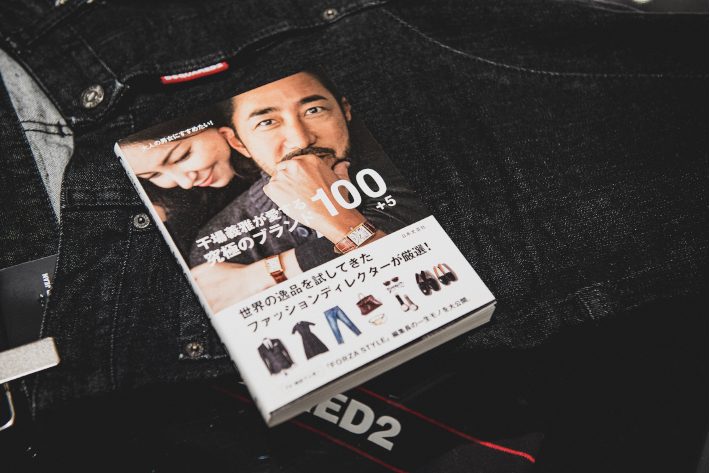
ジェンテ ディ マーレでは、ほかに2010年にフィレンツェのエンポリで誕生したダウンウェア専門のアウターブランド「DUNO(デュノ)」もおすすめ。上質な素材と先端技術を駆使し、伝統的なイタリアのテイラリング技術を用いているので、都会のシーンでも違和感なくフィットしてくれるのがいい。羽根の抜毛を防ぐためにダブルパックを使っているので、痩せてしまうこともなく長く愛用できる。ダウンジャケットを新調したいなぁと思っているときに知ったブランドで、着ると小顔に見えるのもおすすめのポイントです(笑)。こちらは「GEYSER(ガイザー)」(79,000円)というモデル。

こんなふうに肩がけもできちゃいます。

あとカプリ島の修道院で誕生した「CARTHUSIA(カルトゥージア)」の香水も、カプリに行くたびに買う知る人ぞ知る逸品です。摘みたてのさわやかなレモンリーフに新鮮なグリーンティーの香りが弾ける「メディラネオ」(50ml 12,000円)が特に気に入っています。
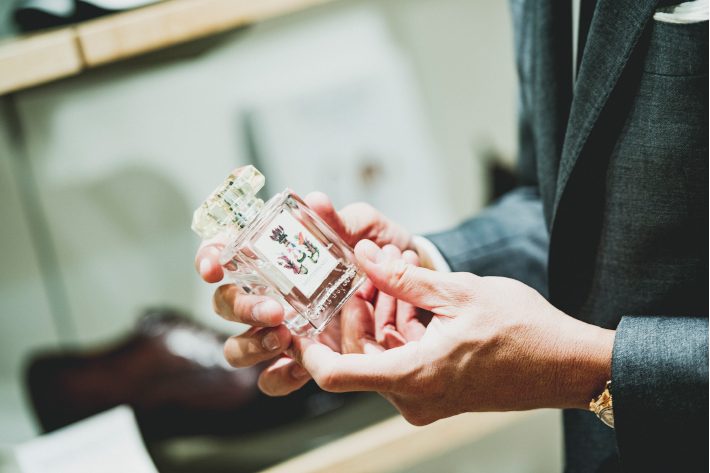
ちなみにカプリ島はレモンが名産で、カルパッチョにもレモンをたっぷりかけるし、レモンチェッロもめちゃくちゃ充実していて、行けば必ず気絶できる! そして僕にとっては食べ物も、高かろうが安かろうが、気絶できるほど美味いかどうかが大事。GINZA SIXの散歩では、たいがい「銀座大食堂」でうな重か親子丼を頼んで、その後の激務に向けて腹ごしらえをします。親子丼に至っては「今日は味がちょっと濃いめだな」とか、要するにそれくらいの頻度で食べてます(笑)。
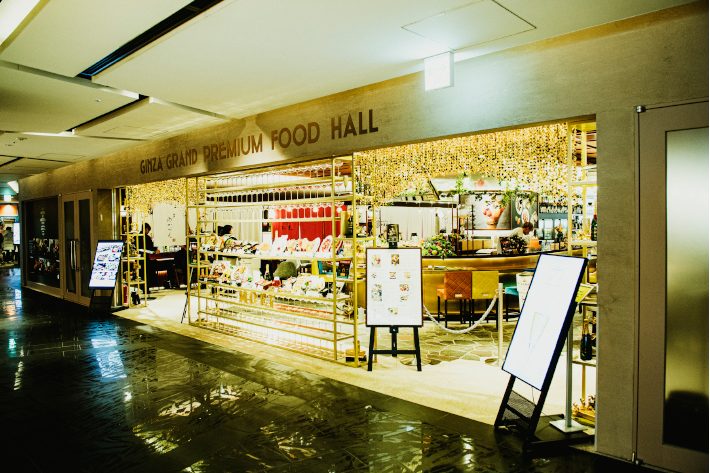
この日は鰻重(4,000円)をオーダー。国産の鰻と九州赤酒を使用したタレとの相性が抜群なんです。
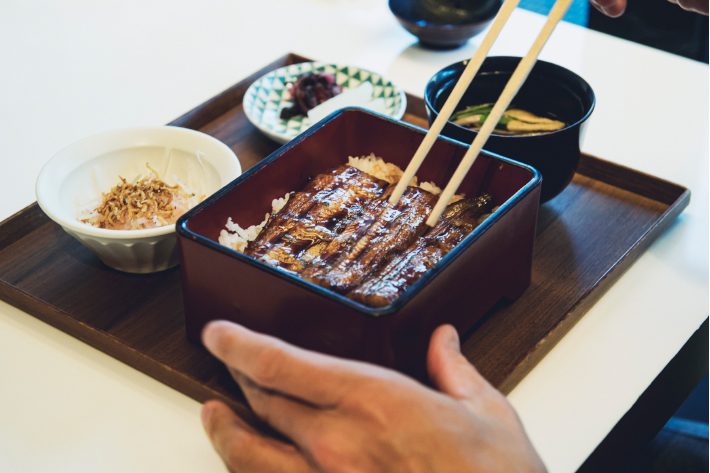
特等席を探すなら、銀座の中央通りを上から眺めることができるテラスに面した窓辺は、昼なら自然光が気持ちよくて、おすすめです。
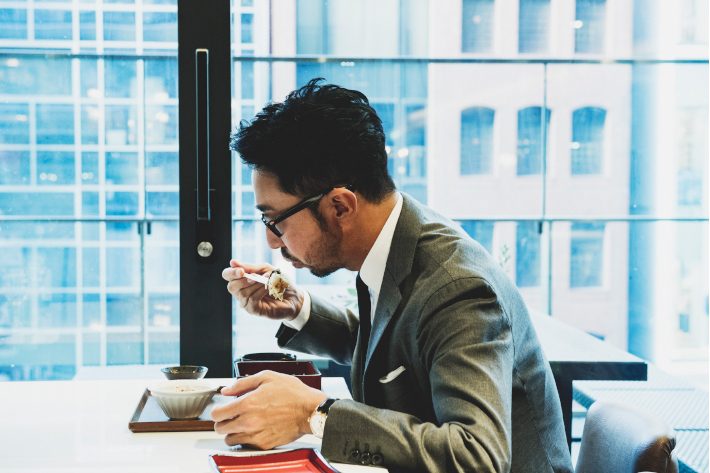
そして散歩の最後は、銀座大食堂からすぐ横の「銀座 蔦屋書店」へ。アートブックからファッション写真まで、仕事の参考になりそうなものやインテリアとしても成り立ちそうなものを多いときは10冊くらいまとめ買いして、自宅に送ってもらいます。
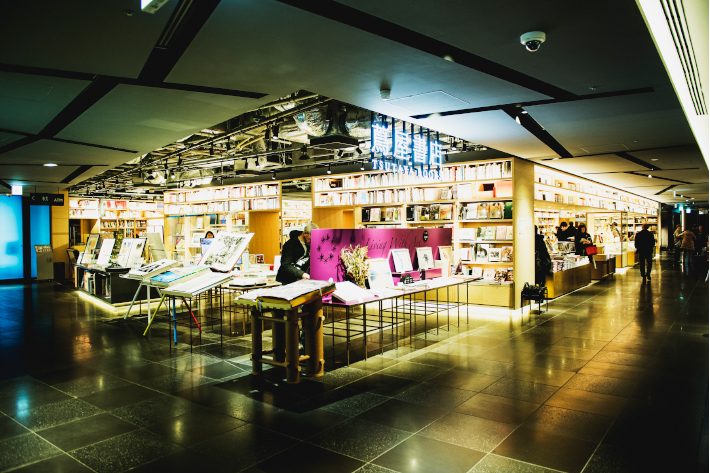
この日はファンでもあるブルース・ウェーバーの写真集が気になり手に取っていたところ…。
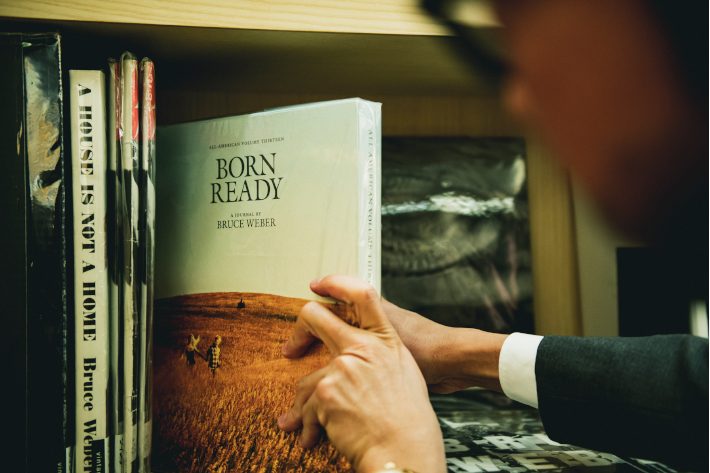
そんな僕の様子を見て、銀座 蔦屋書店にストックされているお宝写真集を知り尽くし、それらのバイイングも担当しているという写真コンシェルジュの番場文章さんが、ブルース・ウェーバーのとっておきの2冊をお勧めしてくれました。
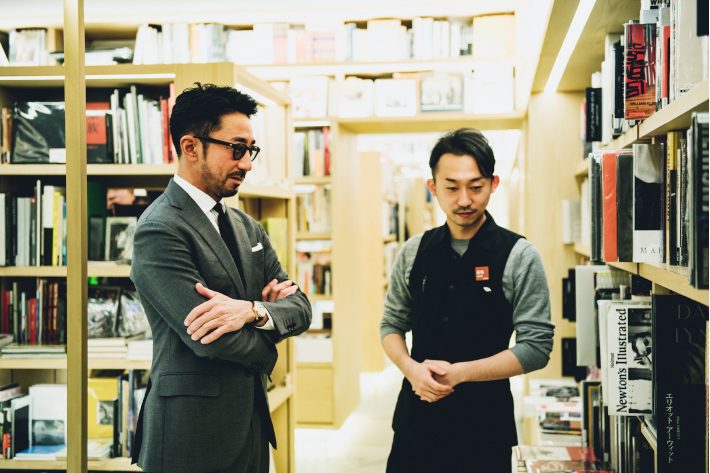
一冊は1991年当時、ロスのFahey/Klein Galleryと東京のParco Exposure Galleryでの展覧会のために制作された1991年の写真集で、テキストはなんと1997年に亡くなった20世紀を代表するアメリカの小説家の一人ウィリアム・バロウズが書いているという「BRUCE WEBER」(12,000円)。もう一冊はアンディ・ウォーホルが創刊した雑誌の1984年ロサンジェルス・オリンピック特集『Andy Warhol's Interview magazine 1983 Jan/Feb United States Olympic Special』(29,000円)。アメリカ代表のアスリートたちの肉体美を、ブルース・ウェーバーが撮り下ろしています。表紙からして、もうグッときて、ヤバイ感じです。もちろん買いました!
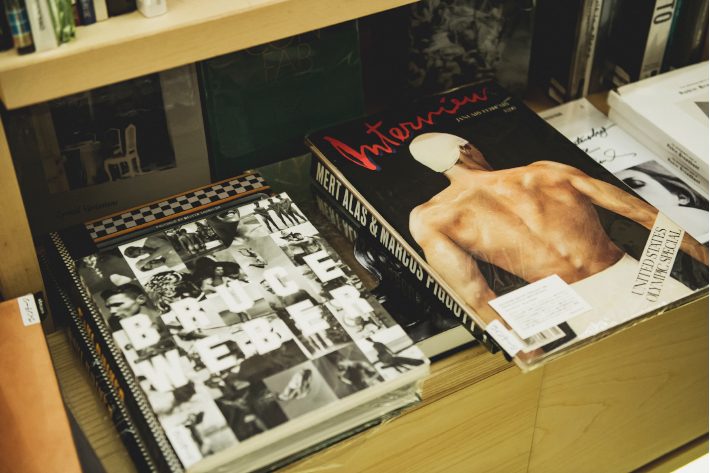
以上、GINZA SIXで“干場型”を作るいつもの店を巡ってみましたが、今でこそ自分のスタイルが定まったとはいえ、そこに到達するまではいろいろなものを買っては、たくさんの失敗をしてきました。
でも、すべてスタイルが定まることで、男性も女性も、自分を輝かせることができると思うんです。
良質なものばかりが揃うGINZA SIXは、それらを選び抜く確かな眼を養う格好の散歩ができる場所だと思うので、皆さんもぜひ行って、気絶してみてはいかがでしょうか?
Text:Yoshimasa Hoshiba Photos:Yuichi Sugita Edit:Yuka Okada(edit81)
I was born into a family of tailors in Tokyo, three generations. From the time I was a young child, I had lots of opportunities to accompany my father to Ginza. We would go around by car to the wholesaler district to the fabric shop and button dealer, and then lastly to Ginza to the clothing store. This was the route my father always took for his job.
Around the time I turned 20, my father said, “You’re just about a grown man now, so you need a good suit!” With that, he made me one of navy blue. He added: “As an adult, you need to know about places like this,” and had me put on the suit he made and took me to one of Ginza’s exclusive clubs. It was after the economic bubble had burst in the early 90s, but the club was full of beautiful women in beautiful makeup and alluring perfume, the kind of women you don’t see every day. I remember concluding beautiful women are a very good thing!
Ginza became something more immediate when I was around 26. I’d worked as an editor at a number of publishers and after a while, I started working in the editorial department of LEON, the popular men’s magazine. The department was located near Ginza 1-chome, Kyobashi. I was there pretty much every day, so I became fairly familiar with the district.
Among all the places in Ginza where I have memories aplenty, one of my favorites is GINZA SIX. It’s simply because my favorite stores are there. Today I’ll briefly introduce you to the walking course I always take, one that always elicits sighs of delight, if not fainting spells.
I go first to DSQUARED2 on the third floor. From there I go see Neil Barrett, located across and to the left of DSQUARED2. Next is Gente di Mare, up the elevator on the fifth floor. I eat at Ginza Grand Premium Food Hall on the sixth floor, and afterwards make my way to Ginza Tsutaya Books.
I love each of these places, and each is indispensable in creating my trademark Hoshiba style.
Today, I venture first to DSQUARED2, which participates in Milan Fashion Week and carries a host of catchy items.

I love the denim in particular.

The type called Tidy Biker creates a tapered silhouette from thighs to hem. They’re high-rise but made to be worn low on the waist. DSQUARED2 designs are worn this way; they make your legs look short, which is offset by creating a long-looking torso that may happen to accentuate your obliques, a look the brand pioneered. Today I try on the Tidy Biker model for fall/winter 2019 (60,000 yen; all prices listed before tax).

In my case, my ideal style eliminates frills, doesn’t rely on a color or pattern, blends into its surroundings, and brings out the qualities of the individual wearing it. Of my close to 40 pairs of denim, most are black. Lately I’ve considered buying another pair of black denim, so, today, I’m entirely in full-on shopping mode.

DSQUARED2 denim puts the tag next to the zipper, a rather sexy position. I’m currently 46 years old. I’ve shopped at the store since I was 23, and I’ve seen the brand at Milan Fashion Week for the past 23 years as well. Most of the male swimwear models in the DSQUARED2 show have really lean, taut midriffs. They look really cool; super-sexy and very healthy.

In passing, the DSQUARED2 head office in Milan has a members-only gym and spa, as well as Ceresio 7, an Italian restaurant on the top floor I love, where Elio Sironi, formerly of Bulgari Hotel, flashes his skills. There’s a pool there, too. In the summer, it’s a gathering place for the city’s fashionable movers and shakers. The interior space was designed by twins Dean and Dan Caten, DSQUARED2’s designers. The Basquiat and Cocteau artwork in their personal collection are must-sees. It’s a place that embodies the brand’s ethos of eating good food, training the body, and enjoying fashion. You’re encouraged to visit, if you ever have the opportunity.
DSQUARED2’s denim is great, of course, but I can also recommend the suits. They stretch, and the shoulder line is really beautiful. Today I tried on a suit setup with a tight, one-button jacket (158,000 yen).

The suit is called “TOKYO,” because it is inspired by the impressions left by Japanese visitors wearing a short-hemmed jacket at Pitti Immagine. The other suits in DSQUARED2’s line are also named after world cities.
The upper body is contoured precisely, while the lower body is low-fitting and loose. This is the DSQUARED2 look. Next up is Neil Barrett.

I strongly recommend this brand for the ultimate travel suit. It’s a setup that lets you buy the jacket and slacks separately, and the elastic Techno Stretch fabric resists wrinkling. It’s easy to wear. The fabric is strong and retains its shape well, which means it can be creased beautifully and resists stretching out at the knees.

Since his time as director at Prada Uomo, designer Neil Barrett has had a strong reputation as a suit maker. After launching his eponymous brand, he’s continued to design suits like this, which I picture as modern (jacket 139,000 yen; slacks 65,000 yen). I can’t let them go: I have around seven of this type alone in different colors.

On a rather different note, I recently bought these sweatpants (76,000 yen). I’m on trips overseas around two months every year, and these sweats recover their shape well and resist stretching out at the knees too; they’re invaluable on flights.

Next up is Gente di Mare, a mixed-label brand with an ‘Italian coastal boutique’ theme. It’s one of the few shops dedicated solely to European brands. Every time I go I find things men really like and things I didn’t know about at all, so I’m very much a fan of the shop.

For example, this navy blue coat (79,000 yen) is from the outerwear brand HEVO, which was established in 2010 in Puglia, Italy. Coat styles have changed a great deal in the past few years, but this brand was ahead of the game in incorporating women’s trends into men’s fashion: big silhouettes, rounded A-lines, and the drop shoulders of raglan sleeves.

It’s made primarily of high-end wool and features a belt at the waist; it feels a bit like a foreign military uniform. I put it on, and it gave me the look of a cool middle-aged dude, no? FORZA STYLE, the online magazine I’m editor in chief of, put in a special order for the coat, and it sold out almost immediately.
The Ultimate 100+5 Brands Loved by Yoshimasa Hoshiba, my recent book, introduces all of these—the HEVO coat, denim from DSQUARED2, and Neil Barrett suits. If you get the chance, the book goes into some detail about quality products from various brands you can use to create your style and silhouette.

At Gente di Mare, I also recommend DUNO, an outerwear brand that specializes in down launched in Empoli, Florence in 2010. Integrating high quality materials, cutting edge technologies, and traditional Italian tailoring techniques, the coats fit naturally into any urban setting. The coats use double packing to keep the down feathers from coming out. They should retain their insulation for a long, long time. I learned of this brand when I was looking for a new style of down jacket. When I tried it on, it made my head appear smaller, which is one of the reasons I recommend it. It’s the GEYSER (79,000 yen).

You can hang it off your shoulder like this as well.

Carthusia fragrance, which comes from a monastery on the island of Capri, is a treasure known only to very few, and is something you should never forget to buy when visiting the island. Invigorating, fresh-picked lemon leaf mingles with the aroma of fresh green tea to produce the fragrance Mediterraneo (50 ml, 12,000 yen), the one I especially like.

Incidentally, Capri is famous for its lemons. Even the carpaccio is doused with lemon, and the limoncello is so, so good. It’ll leave you swooning. When it comes to food, cheap or expensive matters less than whether it’s so delicious you feel faint. On my walks at GINZA SIX, I usually go to Ginza Grand Premium Food Hall, order broiled eel in a box or chicken-and-egg rice bowl, and fortify myself for a stretch of hard work. With the chicken-and-egg rice bowl, I’ll think, “It tastes a bit rich today” or some such thing—that’s how often I have it.

Today, I order the broiled eel in a box (4,000 yen). The domestic eel and sauce with Kyushu red sake go together perfectly.

If you’re looking for a great place to sit, I recommend the area near the windows facing the terrace. Here you can look down on Chuo-dori. The natural sunlight in the afternoon feels great.

My last stop on my walk is Ginza Tsutaya Books, right next to the food hall. From art books to fashion photo collections, I’ll sometimes buy as many as 10 volumes, including books for work and books that could serve as interior décor, and have them shipped to my house.

Today, I pick out a photo collection from a photographer I really like, Bruce Weber.

Seeing me, the photography concierge Fumiaki Bamba, who knows everything about the treasured photo collections in stock at Ginza Tsutaya Books and is also a buyer, recommends two special Bruce Weber titles.

The first is a photo collection from 1991 made for exhibitions that year at the Fahey/Klein Gallery in Los Angeles and the Parco Exposure Gallery in Tokyo, with text by William S. Burroughs, a major American author who died in 1997. It’s titled Bruce Weber (12,000 yen). The other is the inaugural issue of a magazine produced by Andy Warhol for the 1984 Los Angeles Olympics, Andy Warhol’s Interview Magazine 1983 Jan/Feb United States Olympic Special (29,000 yen). It features Bruce Weber photographs of the physical beauty of U.S. Olympic athletes. Judging by the cover, it looks arresting, totally wild. Of course I buy it.

This completes my tour of several places at GINZA SIX that help create my signature Hoshiba style. While my basic style is set at this point, getting here was no easy task. Along the way I have bought a lot and made many mistakes.
But once your style is in place, whether you’re a man or woman, you can make yourself shine.
GINZA SIX is full of high-quality products. It’s a good place for a good walk to develop a fine eye for what’s right for you. I encourage everyone to go and find the things that make you swoon.
Text:Yoshimasa Hoshiba Photos:Yuichi Sugita Edit:Yuka Okada(edit81)
干場 義雅
1973年生まれ。ファッションディレクター。『FORZA STYLE』(講談社)編集長。雑誌『MA-I』『モノ・マガジン』『エスクァイア日本版』など男性雑誌の編集を経て、『LEON』『OCEANS』の創刊に携わり、“ちょい不良オヤジ”ブームを作る。2012年株式会社スタイルクリニック設立。船旅を愛する男女誌『Sette Mari』の編集長を務めたほか、TOKYO FMのラジオパーソナリティ、テレビ番組のファッションコーナー、トークイベントなど、メディアの枠を超えて幅広く活動中。YouTubeの人気番組B.R.CHANNEL「ファッションカレッジ」では講師を務め、ブランドのプロデュースも積極的に行なっている。著書も多数。Instagram @yoshimasa_hoshiba


